It seems to me that for the last two years or so, a lot of what I do on a daily basis is tagging stuff. All sorts of stuff, like bookmarks, wiki pages, blog posts, videos, etc. It seems to me that it really makes my digital life more efficient, more enjoyable, and it makes my stuff easily findable.
The idea of adding keywords to information is nothing new. All research papers have had keywords for a while. Tags are also not new; we all have tags on our clothes to indicate how to take care of them, nutrition information is on almost all food products, street signs indicating civic numbers range (not in Delaware, but elsewhere) and price tags help us make buying decisions.
I stumbled upon the concept of tagging people from Cole Camplese and Allan Gyorke, from Penn State University. These two links show how they implemented the tagging idea to people attending a learning design workshop:
Tagging Participants at the Winter Faculty Institute
Organized by IT-User Services, the Winter Faculty Institute Kick-off Event at the University of Delaware (UD) is a conference day targeted at faculty members at UD. In the past, it has mostly been a passive half-day of presentations, including faculty showcases of teaching and learning innovations and a keynote speaker. I was put in charge of the 2009 edition and wanted to shake off the format a bit, with the intention of getting attendees to be active participants. That's why we added a half day of actitities durring the afternoon, starting with a technology-enhanced poster session.The full agenda, links to videos, and pictures are all linked from the event page: http://www.udel.edu/present/winter
To stimulate conversation and get people thinking about educational technologies, we gave each participants a set of stickers representing different topics, technologies, interests, etc., along with a sheet of instruction with their nametag.
The stickers we home made, using Avery sticker sheets (model 5167), a color printer, and a paper cutter. We could do four sets of tags per sheet, so the whole process was not expensive at all.
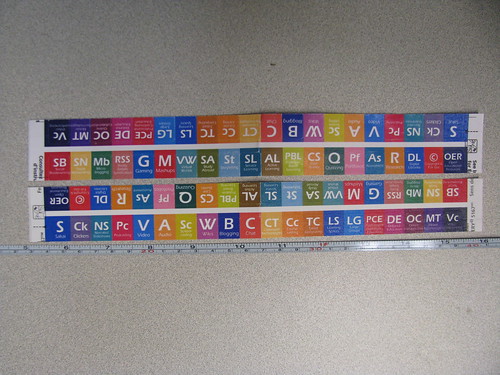
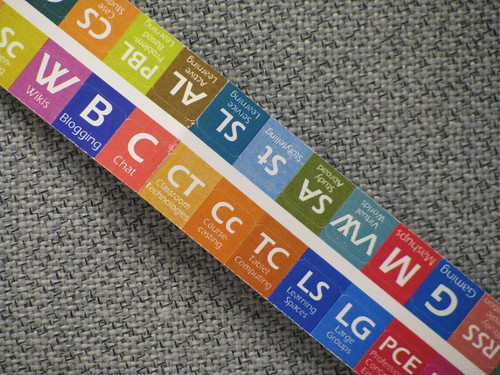
The sheet of instructions was only there to provide an overview of what was expected of the participants, and also to give them an idea of some the concepts they might have not been exposed to yet.
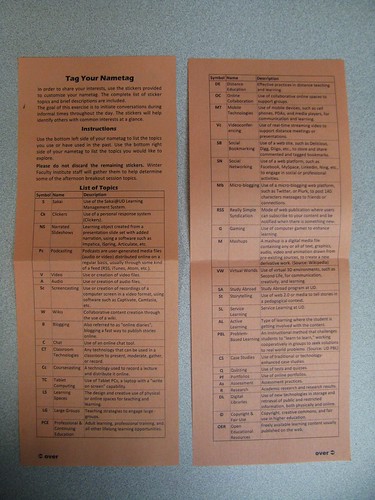
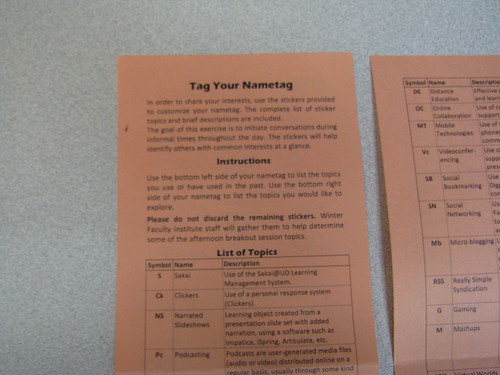
The nametag was designed to let people tag the tools, technologies, or concepts they already used (on the left), and the ones they were curious about (on the right). You could see the personality of some of the attendees shine through their nametags. Some were really clean and had just a couple of stickers on them, while others were completely filled up with stickers going in every direction. Below is a picture of mine.
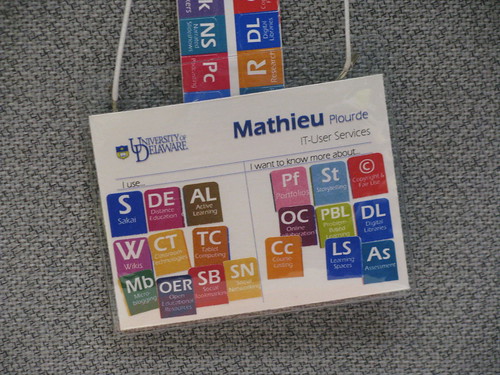
We also used the tags on the posters, so that people could select the topics they were more interested in at a glance.
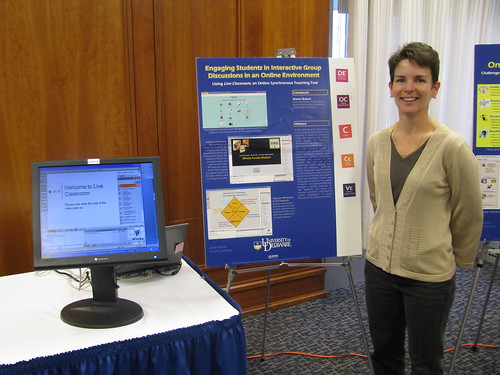
Before lunchtime, we collected the remaining stickers to count the missing ones. We ended up selecting two of the breakout discussion topics through that process. Even though the two selected topics were obviously popular, they did not attract as many people as expected, since there were already 5 other topics that were pre-selected, including a discussion around our brand new Sakai Learning Management System.
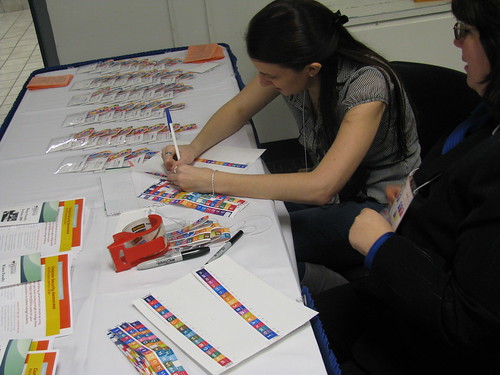
Results From the Evaluation Form
After the WFI was over, we sent out an online evaluation form to gather some feedback about the day-long event. As promised to Cole and Allan, I included two questions about the tagging activity. 36 participants out of 120 attendees, mostly faculty members at UD, answered. Here are the results:Question 14: Did you find the stickers (tags on your name tag) useful to stimulate conversation with your peers?

A lot of people did not find the stickers useful to stimulate conversation... I was a bit taken aback by this at first, but at the same time, I designed the question to address this specific aspect of "conversation starter".
Question 15: Comments and suggestions on the use of stickers.
I did not copy every comment here, since those below are representative of the overall feeling about this activity. A lot of comments also gravitated around the fact that they were fun.
Here are some positive comments and suggestions that came up:
The stickers [...] made me think about my own use of technology. I liked them, but I can't say they were very useful.
It was interesting because it made me realize how many technologies I'm already using/exploring. And it alerted me to some I know nothing about.
It could be used as an icebreaker activity... Find a person who uses the tool that you want to learn about and ask them a question.
Here are some issues that were written down in this field:
There really isn't much time to talk to peers, unless you'd do an exercise to do this (or build more time in).
The stickers were too small, it was hard to read the titles.
There were too many stickers on most nametags; perhaps limiting people to a small maximum (3-5) each for "use" and "interested in" would make the stickers more useful.
I did not make a concerted effort to look at other's stickers.
I would of liked to have learned more about many of them or how they might be used in education. . . Maybe a website or handout with some information would be helpful.
Lessons Learned
Now that this activity is a thing of the past, here are some lessons I have learned:- A day-long event might not be enough to really leverage a people-tagging activity. Our Summer Faculty Institute, where participants are engaged for a whole week, might be a better context for this.
- Make sure your stickers are big enough. People might have a harder time selecting their stickers because of the limited space on their nametag, but it might achieve the goal of getting people to discuss better.
- If you can build an activity, like that ice-breaker idea that was suggested in the comments, it should make the process more efficient.
- Attendees like it when conference people do a follow-up on key questions that were raised during an event. I'll try to aggregate other results and lessons learned, modify some of our support material and strategies, and post the information to them.
Have you ever experienced a conference or organized an event where people tagged themselves or stuff around them? Do you have stories to share about this?

2 comments:
Hey Mathieu. Thanks for providing this information about the stickers. The open-ended comments were especially interesting. I think a second run of an event with stickers may prove more useful since people will be a bit better prepared to use them. Also, too many sticker choices and too many stickers on a badge could definitely be an issue. We were really successful with the use of stickers was when we had attendees create their own before the event. Coming into the event, they knew about the stickers, understood how they were to be used, and felt ownership of them since they helped design them. In any case, if they helped a few more people make a few more connections with others, then I'd count that as a positive step.
Post a Comment